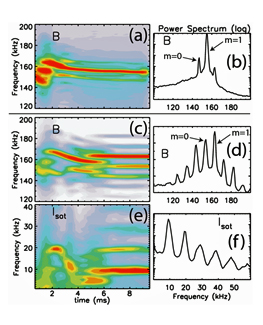
Magnetohydrodynamic (MHD) turbulence has been invoked to explain the measured spectrum of magnetic fluctuations in the solar wind, turbulence in the interstellar medium (which causes scintillations in radio astronomy), and angular momentum transport and heating in accretion disks. In the ideal, incompressible MHD model, interactions between counter-propagating Alfven waves are responsible for the turbulent energy cascade.
Motivated by this picture, we are studying interactions between Alfvén waves in LAPD (Graduate student: Brian Brugman, work in collaboration with Dr. Patrick Pribyl; theory collaboration with Prof. Steven Cowley and members of the CMPD). We generate large amplitude waves using a resonant cavity (the Alfven wave maser) or using antennas and novel broadband, high-power drivers. Alfvén waves in LAPD (and near the dissipation scale in astrophysical plasmas) are dispersive kinetic or inertial Alfvén waves.
We have conducted experiments in which two co-propagating Alfvén waves beat together due to dispersion (which allows waves with differing frequency to pass through one another). The beat wave drives a density fluctuation (a nonlinear pseudo mode) which in turn scatters the Alfvén waves, creating a series of sidebands (T.A. Carter, B. Brugman, P. Pribyl, W. Lybarger, Phys. Rev. Lett. 96, 155001, (2006).).
A related project is being carried out on the Madison Symmetric Torus (MST) at U. Wisconsin (Graduate student: Travis Yates, work in collaboration with Dr. David Brower, Dr. Weixing Ding, and the MST team). There faraday rotation measurements using an FIR laser are being used to study broadband magnetic fluctuations, which may be the result of a turbulent cascade driven by tearing modes but could also be driven by shear flow or by density gradients in MST (drift-Alfven waves).
Click here for a movie of cross-field structure of interacting waves (driven m=0 ("lower") and m=1 ("center") waves along with upper sideband and density fluctuation).
For information on other plasma physics research activities at UCLA, visit the Plasma Science and Technology Institute website.